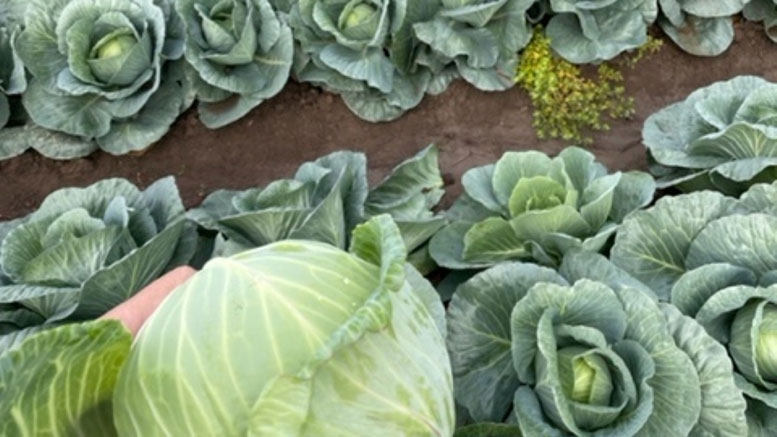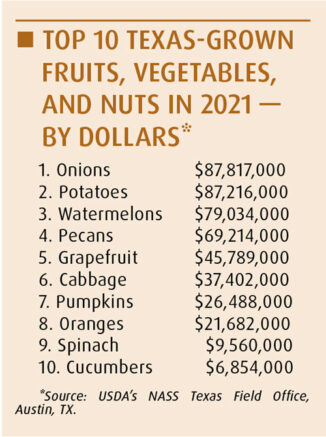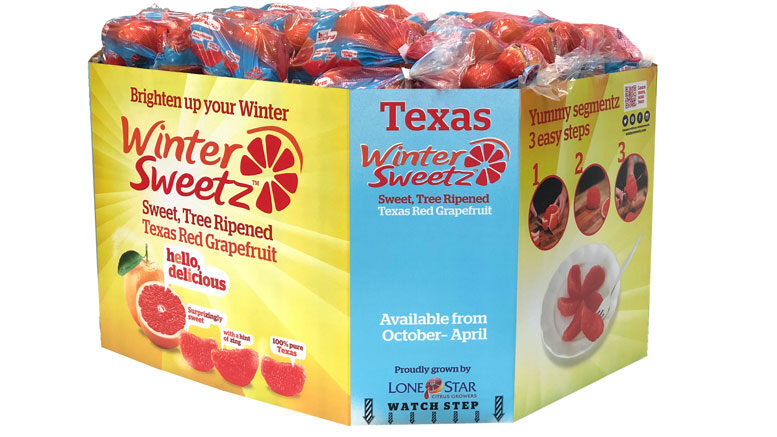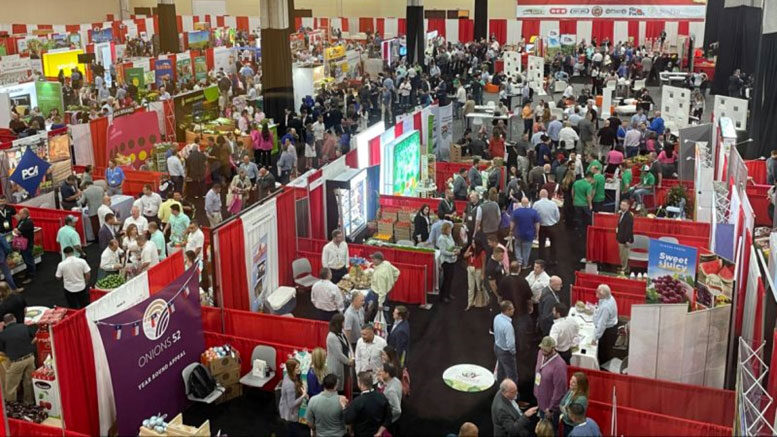TEXAS KEEPS FRESH PRODUCE FLOWING
April 25, 2023 | 11 min to read
The Lone Star State plays a pivotal role in the U.S. fresh produce supply chain, particularly in winter, ranking highly in citrus, spinach, and other vegetables. Its strategic location enhances transit efficiency from Mexico to the Midwest and East Coast. The growing focus on organic produce and partnerships with Mexican farms allows Texas to offer year-round fresh items while tackling challenges like labor shortages and transportation. Texas pride also drives consumer preference for locally grown products.

PHOTO COURTESY TEXAS DEPARTMENT OF AGRICULTURE
The Lone Star state’s climate and key geographic location pushes fresh fruits and vegetables across the U.S.
Originally printed in the April 2023 issue of Produce Business.
Cattle is the agricultural king in Texas. But man doesn’t live by steak alone.
Fresh Texas-grown fruits and vegetables fill a strategic U.S. supply niche during the winter. This is especially true for citrus — Texas is ranked third in U.S. production, according to the U.S. Department of Agriculture’s National Agricultural Statistics Service (NASS) — as well as spinach (fourth), cucumbers (sixth), cabbage (seventh), onions (eighth), watermelon (eighth) and pumpkin (10th).
“Texas is absolutely critical to the U.S. fresh produce supply chain. We’re one of only a very few regions in the country that can grow fresh produce during the winter. The large size and various regions in the state offer a wide selection of items throughout the entire year,” says Dante Galeazzi, president and chief executive of the Texas International Produce Association (TIPA), headquartered in Mission, TX.
“Add to that recipe the fact that Texas crosses more than 50% of all the fresh produce coming from Mexico and that transit times and costs to the Midwest and East Coast are shorter and cheaper, and I don’t see a national retailer that isn’t sourcing from Texas.”
TEXAS-SIZED ADVANTAGES
Texas plays a vital role in supplying fruits and vegetables to Robert Fresh Market and its sister store, Lakeview Grocery, a six-store chain headquartered in New Orleans, according to Terry Esteve, produce director.
“Probably 80% of our watermelons come from Texas. Texas Rio Star Ruby Red Grapefruit, if you’re a grapefruit lover, you know there’s nothing better,” Esteve says. “We have a local cabbage season here in Louisiana, but throughout the year, Texas is a major supplier of cabbage to our state. We relied on them heavily for the New Year’s cabbage ad, after we were hit with a brutally cold freeze in mid-December that wiped out almost all of the local cabbage.”
“There are also times like this past holiday season when California was having weather issues, and we were bringing in parsley and carrots from Texas,” he adds. “I know many folks think of the West Coast and East Coast when it comes to vegetables, but Texas, more often than not, fills the gaps when the weather wreaks havoc on those guys.”
Texas’ middle-of-the-U.S. location, away from the other major wintertime producers of California to the West and Florida to the East, gives Texas a clear strategic shot at supplying retailers, not only in neighboring states, but north up the center of the nation.
“Texas’ geographic location is important to retailers in the Midwest, as it’s a direct route from them to us,” says Randy Bohaty, produce director for B&R Stores, a 20-location chain based in Lincoln, NE, which operates under the Russ’s Markets, Super Saver, Grand Center Apple Market and Allen’s Food Store banners.
While Florida handles about 80% of the distribution on the East Coast, says Zak Laffite, president of Delano, CA-headquartered Wonderful Citrus, which grows its grapefruit in Texas, “we supply the rest of the Northeast, Midwest and Southwest from Texas and have a strong brand following in those locations.”
“That said, we did have a Northeast retailer try Texas grapefruit for the first time as part of a Citrus Fest promotional theme, and the fruit added excitement.”
A major supply artery is Interstate 35, which runs from Laredo near the Mexican border to Duluth, MN. Within the state, Interstate 45 connects Galveston on the Gulf of Mexico with Houston and Dallas.
“The mix of items being grown [in Texas] has increased dramatically over the last few years.”
— Dante Galeazzi, Texas International Produce Association
Mobility on roadways for trucks has become a challenge through the central part of the state, according to the TIPA’s Galeazzi. “Luckily, a lot of new projects and roads are underway throughout the state, so at least that challenge is being immediately addressed.”
However, Galeazzi adds, this transportation hurdle and issues like labor shortages, water and urbanization driving up land costs “have driven producers in the state who want to expand their businesses to consider production or partnerships south of the border to complement their domestic programs.”
Since the Texas season spans from October to March, partnerships with farms in Mexico let Texas growers supply retailers for 12 months of the year.
“We’re always looking for what else we can put in our inventory to be a year-round solution for our retailers,” says Tommy Wilkins, director of sales for Donna, TX-based Grow Farms Texas, a sister company of the Horton Fruit Co., in Louisville, KY.
Grow Farms Texas supplies Texas-grown cabbage and onions as well as mangos, avocados, peppers, cucumbers, squash and beans from Mexico.
Underscoring Texas’ strategic border location and excluding avocados, about 38% of Mexico’s fresh fruit and vegetable exports flow through Laredo crossings, 30% through Nogales, AZ, and 17% through San Diego, CA. Most avocados from Mexico are also shipped through Laredo, according to the USDA’s Foreign Agricultural Service’s United States-Mexico Agricultural Trade Logistics Review, published Dec. 23, 2022.
WHAT’S NEW
TIPA’s Galeazzi says Texas fruit and vegetables are entering a new phase. “We’re seeing the next generation start to take the helm, and with that leadership shift, the industry is experiencing many changes. We’re modernizing. Growers are experimenting with new machines and techniques. The mix of items being grown has increased dramatically over the last few years, as growers and shippers have pivoted to provide a wider breadth of commodities to their customers.”
One example is a new celery program for the family-owned Val Verde Vegetable Co. Inc., in McAllen, TX, which started with conventional and organic celery, both naked and bagged this year, according to Frank Schuster, president. “My son, Max, is the farmer of the family, and he’s always searching the horizon for what is coming into demand and fits with our production program.”
Organic production is increasing in Texas. According to data from Texas A&M College of Agriculture and Life Sciences Department of Agricultural Economics, the number of acres in the state devoted to organic production increased by 97% from 2014 to 2019, with U.S.-certified organic acreage up by 51% during this same time. Production includes crop, pasture and range land.
“We offer a full mix of organic cabbage, parsley, Swiss chard, cilantro, tied and bulk red and gold beets, green and Tuscan kale and onions,” Val Verde’s Schuster. “We started into organics five to six years ago. It has continued to grow, and currently, we’ve transitioned about 15% of our conventional farmland to organic.”
Packaging enhancements, like value-added, are something that grower-packers such as Edinburgh, TX-based Little Bear Produce has recently added. The company now offers 1-pound bags of fresh-cut kale, collard greens, mustard greens, turnip greens and a greens trio with collard, turnip and mustard greens.
“The value-added side of our business is growing,” says Jeff Brechler, in sales. “We launched these products in February 2022 and everyone warned us to be ready for the November and December holiday push. Not only did we supply the volume ordered, but we have received a great response and acceptance from retailers due to the product quality.”
Lastly, Texas has also seen a very rapid growth of Controlled Environment Agricultural organizations, Galeazzi adds. “Houston, Dallas, Austin, even San Antonio have seen the emergence of large producers, feeding the growing populations of these metroplexes and the surrounding communities.”
TOP CROPS
While Texas’ main growing season is fall to spring, there are fruits and vegetables to source out of the state year-round. For example, Texas greens like kale, chards and mustard greens are available for New Year’s resolutions in January. Come St. Patrick’s Day in March, Texas cabbage is in full supply. And spring is when growers are ready to rock with Texas 1015 sweet onions.

In May and for the summer holidays, there are Texas-grown cantaloupes and honeydews. With 25,000 acres, the supply is solid on Texas melons throughout the entire summer, according to Galeazzi. Finally, as winter approaches, there’s Texas citrus, like the Rio Star Red Grapefruit.
ONIONS. The value of Texas-grown onions amounted to $87.8 million in 2021, the latest statistic year available from the USDA’s NASS Texas Field Office in Austin, TX.
“The Texas 1015 sweet onions start a month before Vidalias, giving our customers an earlier domestic sweet onion,” says B&R Store’s Bohaty.
There are almost 100 Texas onion growers across 35 counties, growing more than 7,000 acres this year, according to Galeazzi, who is also the marketing order manager for the South Texas Onion Committee, in Mission, TX.
“The Texas 1015 Sweet onion is the official state vegetable of Texas and is the first domestic onion — sweet or otherwise — of the year. That out-of-the-gate opportunity in March with the first domestic sweet onion is a real promotable opportunity for retailers to kick off the sweet onion category for the spring season.”
He adds there are two Texas growing regions for TX1015 sweet onions — the Rio Grande Valley in deep south Texas and the Uvalde Winter Garden region in south-central Texas, which creates a longer window of availability through the end of June or early July and helps insulate against weather-related slowdowns.
Sweet onions are a big part of the overall onion business at United Supermarkets, a 95-store chain based in Lubbock, TX.
“There are sweet onions from Peru and Mexico in March that are good, but any time we can buy locally, that is a great option for us,” says Joseph Bunting, United’s produce business director. “When our guests see that we have Texas Sweet onions back in our stores, they tend to buy more sweet onions.”

PHOTO COURTESY LONE STAR CITRUS
CITRUS. Texas-grown citrus was valued at $45.8 million and $21.7 million for grapefruit and oranges, respectively, in 2021, according to the USDA’s NASS Texas Field Office, in Austin, TX. Weather setbacks starting with Hurricane Hanna in 2020, a devastating freeze in 2021 and lingering drought issues have taken a toll on the state’s citrus crop. Specifically, production that totaled just over 17 million cartons of citrus in the 2018-2019 season fell to just under 4 million cartons packed in 2021-2022, based on data from the Texas Citrus Mutual, in Mission, TX.
“Our season begins in October, hits full stride by mid-November and typically winds down in late March or early April,” says April Flowers, marketing director for Mission, TX-based Lone Star Citrus Growers, which markets its fruit under a variety of labels, including the popular Winter Sweetz.
“Fruit has been smaller, on the whole, this year as a result of drought following the ’21 freeze. Despite that, the fruit is sweet as ever. We expect to be back up to 80% production next year.”
The Texas citrus season is the opposite of California. This gives growers a chance to fill a large gap in supply, adds Flowers, while offering a sweeter fruit than is typically found in the summertime.
Florida and Texas share the same citrus season. However, Wonderful Citrus’ Laffite says the company out-shipped the Sunshine State in grapefruit in 2020. Wonderful sells its Texas red grapefruit under its Sweet Scarletts trademark.
“Our goal is to position ourselves as the leader in the winter grapefruit space,” says Laffite. “It’s also been to rethink the grapefruit category.”
“Citrus consumption is flat,” he explains. “We’ve reintroduced a bulk purchase to make it easier for consumers to pick up one or two fruits for snacking. We still have our packaged product, but that can lock some customers into a minimum purchase. We suggest a good way to grow consumption is for retailers to offer two SKUs of grapefruit, bulk and bagged.”
SELL MORE WITH TEXAS PRIDE
Texans like to buy Texas products, says Reb Wayne, communications director for the Texas Department of Agriculture (TDA), in Austin, TX. “A good example is last year’s state fair. The GO TEXAN Pavilion featured over 100 Texas-based businesses, was visited by some 250,000 attendees and generated more than $1 million in sales.”

PHOTO COURTESY TEXAS INTERNATIONAL PRODUCE ASSOCIATION
GO TEXAN is a TDA initiative dedicated to supporting Texas-based businesses and connecting customers across the state, nation and world.
Emphasizing Texas-grown boosts sales, according to United Supermarket’s Bunting, because the stores’ Texas guests love to buy locally grown items. For example, “once the Texas 1015 season begins, we offer promotions to let the guests know that the Texas sweet onions are back in stores. We offer bulk promotions and bagged promotions with large Texas-grown signs to call out that the product is grown in Texas.”
Texas and the Go Texan logo carry clout with shoppers outside the state, too.
“We have primary and secondary vendors that source from Texas,” says Katie Macarelli, manager of public relations for Lakewood, CO-headquartered Natural Grocers, the largest family-owned organic and natural grocery retailer in the U.S. with 166 stores in 21 states.
“UNFI has sourced grapefruit for us from South Texas Organics, and FreshPoint Dallas has purchased citrus from McDaniel Fruit; organic citrus and onions from South Texas Organics; shiitake mushrooms from Texas Organic Mushrooms; and organic kale, beets and cabbage from the Val Verde Vegetable Co,” Macarelli explains. “Our produce managers are great about educating our crew about our vendors. In turn, our crew then educates our customers about where their premium-quality produce comes from.”
7 of 23 article in Produce Business April 2023

